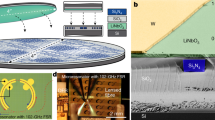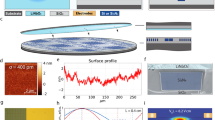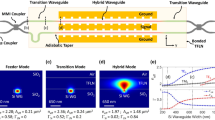Abstract
Optical isolators are indispensable components of almost any optical system and are used to protect a laser from unwanted reflections for phase-stable coherent operation. The emergence of chip-scale optical systems, powered by semiconductor lasers that are integrated on the same chip, has generated a demand for a fully integrated optical isolator. Conventional approaches, which rely on the use of magneto-optic materials to break Lorentz reciprocity, present substantial challenges in terms of material integration. Although alternative magnetic-free approaches have been explored, an integrated isolator with a low insertion loss, high isolation ratio, broad bandwidth and low power consumption on a monolithic material platform is yet to be achieved. Here we realize a non-reciprocal travelling-wave-based electro-optic isolator on thin-film lithium niobate. The isolator enables a maximum optical isolation of 48.0 dB with an on-chip insertion loss of 0.5 dB and uses a single-frequency microwave drive power of 21 dBm. The isolation ratio remains larger than 37 dB across a tunable optical wavelength range from 1,510 to 1,630 nm. We realize a hybrid distributed feedback laser–lithium niobate isolator module that successfully protects the single-mode operation and linewidth of the laser from reflection. Our result represents an important step towards a practical high-performance optical isolator on chip.
This is a preview of subscription content, access via your institution
Access options
Access Nature and 54 other Nature Portfolio journals
Get Nature+, our best-value online-access subscription
$29.99 / 30 days
cancel any time
Subscribe to this journal
Receive 12 print issues and online access
$209.00 per year
only $17.42 per issue
Buy this article
- Purchase on Springer Link
- Instant access to full article PDF
Prices may be subject to local taxes which are calculated during checkout




Similar content being viewed by others
Data availability
The datasets generated and analysed in the current study are available from the corresponding authors on reasonable request.
Change history
05 July 2023
A Correction to this paper has been published: https://doi.org/10.1038/s41566-023-01262-5
References
Shu, H. et al. Microcomb-driven silicon photonic systems. Nature 605, 457–463 (2022).
Lundberg, L. et al. Phase-coherent lightwave communications with frequency combs. Nat. Commun. 11, 201 (2020).
Marpaung, D., Yao, J. & Capmany, J. Integrated microwave photonics. Nat. Photon. 13, 80–90 (2019).
Xu, X. et al. 11 TOPS photonic convolutional accelerator for optical neural networks. Nature 589, 44–51 (2021).
Sludds, A. et al. Delocalized photonic deep learning on the internet’s edge. Science 378, 270–276 (2022).
Newman, Z. L. et al. Architecture for the photonic integration of an optical atomic clock. Optica 6, 680–685 (2019).
Wang, J., Sciarrino, F., Laing, A. & Thompson, M. G. Integrated photonic quantum technologies. Nat. Photon. 14, 273–284 (2020).
Trocha, P. et al. Ultrafast optical ranging using microresonator soliton frequency combs. Science 359, 887–891 (2018).
Shams-Ansari, A. et al. Thin-film lithium-niobate electro-optic platform for spectrally tailored dual-comb spectroscopy. Commun. Phys. 5, 88 (2022).
Suh, M. G., Yang, Q. F., Yang, K. Y., Yi, X. & Vahala, K. J. Microresonator soliton dual-comb spectroscopy. Science 354, 600–603 (2016).
Jin, W. et al. Hertz-linewidth semiconductor lasers using CMOS-ready ultra-high-Q microresonators. Nat. Photon. 15, 346–353 (2021).
Yan, W. et al. Waveguide-integrated high-performance magneto-optical isolators and circulators on silicon nitride platforms. Optica 7, 1555–1562 (2020).
Huang, D. et al. Electrically driven and thermally tunable integrated optical isolators for silicon photonics. IEEE J. Sel. Topics Quantum Electron. 22, 271–278 (2016).
Pintus, P. et al. Microring-based optical isolator and circulator with integrated electromagnet for silicon photonics. J. Lightwave Technol. 35, 1429–1437 (2017).
Zhang, Y. et al. Monolithic integration of broadband optical isolators for polarization-diverse silicon photonics. Optica 6, 473–478 (2019).
Bi, L. et al. On-chip optical isolation in monolithically integrated non-reciprocal optical resonators. Nat. Photon. 5, 758–762 (2011).
Lira, H., Yu, Z., Fan, S. & Lipson, M. Electrically driven nonreciprocity induced by interband photonic transition on a silicon chip. Phys. Rev. Lett. 109, 033901 (2012).
Tzuang, L. D., Fang, K., Nussenzveig, P., Fan, S. & Lipson, M. Non-reciprocal phase shift induced by an effective magnetic flux for light. Nat. Photon. 8, 701–705 (2014).
Onural, D., Gevorgyan, H., Popović, M. A. & Dostart, N. Optical isolation using microring modulators. Opt. Lett. 46, 460–463 (2021).
Bhandare, S. et al. Novel nonmagnetic 30-dB traveling-wave single-sideband optical isolator integrated in III/V material. IEEE J. Sel. Topics Quantum Electron. 11, 417–421 (2005).
Doerr, C. R., Dupuis, N. & Zhang, L. Optical isolator using two tandem phase modulators. Opt. Lett. 36, 4293–4295 (2011).
Doerr, C. R. et al. Silicon photonics broadband modulation-based isolator. Opt. Express 22, 4493–4498 (2014).
Herrmann, J. F. et al. Mirror symmetric on-chip frequency circulation of light. Nat. Photon. 16, 603–608 (2022).
Tian, H. et al. Magnetic-free silicon nitride integrated optical isolator. Nat. Photon. 15, 828–836 (2021).
Sohn, D. B., Örsel, O. E. & Bahl, G. Electrically driven optical isolation through phonon-mediated photonic Autler–Townes splitting. Nat. Photon. 15, 822–827 (2021).
Kittlaus, E. A. et al. Electrically driven acousto-optics and broadband non-reciprocity in silicon photonics. Nat. Photon. 15, 43–52 (2020).
White, A. D. et al. Integrated passive nonlinear optical isolators. Nat. Photon. 17, 143–149 (2023).
Bino, Ldel et al. Microresonator isolators and circulators based on the intrinsic nonreciprocity of the Kerr effect. Optica 5, 279–282 (2018).
Saha, K. et al. Chip-scale broadband optical isolation via Bragg scattering four-wave mixing. In CLEO: 2013, OSA Technical Digest QF1D.2 (Optica Publishing Group, 2013).
Abdelsalam, K., Li, T., Khurgin, J. B. & Fathpour, S. Linear isolators using wavelength conversion. Optica 7, 209–213 (2020).
Kitching, J. Chip-scale atomic devices. Appl. Phys. Rev. 5, 031302 (2018).
Wang, C. et al. Integrated lithium niobate electro-optic modulators operating at CMOS-compatible voltages. Nature 562, 101–104 (2018).
Zhu, D. et al. Integrated photonics on thin-film lithium niobate. Adv. Opt. Photon. 13, 242–352 (2021).
He, L. et al. Low-loss fiber-to-chip interface for lithium niobate photonic integrated circuits. Opt. Lett. 44, 2314–2317 (2019).
Williamson, B. I. A. D. et al. Integrated nonreciprocal photonic devices with dynamic modulation. Proc. IEEE 108, 1759–1784 (2020).
Zhang, M., Wang, C., Cheng, R., Shams-Ansari, A. & Lončar, M. Monolithic ultra-high-Q lithium niobate microring resonator. Optica 4, 1536–1537 (2017).
Yu, M. et al. Integrated femtosecond pulse generator on thin-film lithium niobate. Nature 612, 252–258 (2022).
Kharel, P., Reimer, C., Luke, K., He, L. & Zhang, M. Breaking voltage–bandwidth limits in integrated lithium niobate modulators using micro-structured electrodes. Optica 8, 357–363 (2021).
Shams-Ansari, A. et al. Electrically pumped high power laser transmitter integrated on thin-film lithium niobate. Optica 9, 408–411 (2022).
Op de Beeck, C. et al. III/V-on-lithium niobate amplifiers and lasers. Optica 8, 1288–1289 (2021).
Acknowledgements
This work is supported by the Defense Advanced Research Projects Agency HR0011-20-C-0137 (M.Y., R.C., C.R., L.H., K.L., L.S., A.S.-A., H.R.G., L.J., M.Z. and M.L.), ONR N00014-18-C-1043 (R.C. and M.Y.) and N00014-22-C-1041 (R.C. and M.Y.), AFOSR FA9550-19-1-0376 (A.S.-A.) and Raytheon Technology A40210 (L.S.). E.P. acknowledges support by the Draper graduate student fellowship program. The device fabrication was performed at the Harvard University Center for Nanoscale Systems. The views, opinions and/or findings expressed are those of the authors and should not be interpreted as representing the official views or policies of the Department of Defense or the US government.
Author information
Authors and Affiliations
Contributions
M.L. conceived the idea. M.Y. designed the chip with the help of R.C., C.R., L.H. and M.Z. C.R., K.L. and L.H. fabricated the devices. M.Y. and R.C. carried out the measurement and analysed the data with help from E.P., L.S., A.S. and X.R. M.Y. performed the numerical simulations. H.G. and L.J. provided the DFB laser. M.Y. and R.C. wrote the manuscript with contribution from all authors. M.L. supervised the project.
Corresponding authors
Ethics declarations
Competing interests
C.R., K.L., L.H., M.Z. and M.L. are involved in developing LN technologies at HyperLight Corporation. The remaining authors declare no competing interests.
Peer review
Peer review information
Nature Photonics thanks Yeshaiahu Fainman, Juejun Hu and Changzheng Sun for their contribution to the peer review of this work.
Additional information
Publisher’s note Springer Nature remains neutral with regard to jurisdictional claims in published maps and institutional affiliations.
Extended data
Extended Data Fig. 1 Full measurement setup for the LN electro-optic isolator.
Forward and backward spectra of the isolator are monitored using a tunable laser and 2×2 switch (forward: 1 → 3, backward: 1 → 4) to couple light onto the chip. Polarization controllers are used in both directions to couple light into the transverse-electric (TE) waveguide mode. Spectra are measured on an OSA (optical spectrum analyzer). For III-V laser operation, the DFB laser is edge-coupled directly to the isolator chip. The output is then split between a retroreflector and linewidth and relative intensity noise (RIN) measurement to monitor the behavior of the DFB laser with and without isolation.
Extended Data Fig. 2 Stability measurement of the isolation ratio.
a, The isolation ratio as a function of microwave power. The simulation is performed using the fundamental Bessel function \({J}_{0}(\beta )\), where the microwave power is proportional to \({\beta }^{2}\). The highest simulated isolation ratio is limited by the finite sampling points. The experimental data shows excellent agreement with the simulation when the microwave power is detuned more than 0.05 dBm ( ~ 1.1%) from the optimal power. b, The measured isolation ratio over 14 hours at a time interval of 30 seconds. At the beginning, the isolation of 46 dB is achieved at an optical wavelength of 1555 nm and similar microwave setting to that in Fig. 2a & b in the main text (inset: the optical spectrum). To assess the effects of environmental conditions (temperature, air fluctuation, acoustic noise etc), the isolation ratio is monitored as a function of time while keeping all the operation conditions the same. The isolation gradually decreases to 41 dB after 2 hours and stabilizes to a mean value of 41.3 dB with a standard deviation of 0.56 dB over a 12-hour period. The primary reason for the drop in isolation is the polarization variation over time, which is confirmed by the fact that the isolation ratio can be adjusted back to 46 dB after manually adjusting the polarization controller in the setup.
Extended Data Fig. 3 Coupling between DFB laser and LN chip.
a, Quantum well waveguide structure and (inset) simulated output mode of the III-V DFB laser: W = 5 um, HP = 2.5 um, hP = 500 nm, HQW = 450 nm, HN = 4 um; b, Structure of the LN mode converter at the coupling facet: h = 280 nm, w = 250 nm; c, Simulation of the coupling efficiency between the DFB laser mode and LN facet. An anti-reflective coating is added to the laser structure, as in experiment, to minimize reflection between the laser and the air gap. The minimum coupling gap achievable in our experiment is approximately 2 um, corresponding to about 2-dB coupling loss (indicated by the star). This is loss is further verified experimentally on other LN chips.
Extended Data Fig. 4 Optical spectral measurement of the DFB laser - LN isolator module.
The optical spectrum of the DFB laser module when the isolator is turned on and off.
Extended Data Fig. 5 Relative intensity noise (RIN) measurement with the LN-chip-based isolator.
a, The RIN measurement under four different conditions: 1) isolator on, reflection off; 2) isolator on, reflection on; 3) isolator off, reflection off; 4) isolator off, reflection on. The reflected power back into the DFB chip is estimated to be 0.4% (24 dB) of the laser emission power Plaser. The spectral range of the measurement is from DC to 8 MHz. The detector bandwidth is 200 MHz. We observe similar RIN level between the integrated isolator turned on and off while the reflection is turned off. When both reflection and isolator turned on, we observe an increase in RIN. The cause behind this phenomenon is still under investigation since the laser is followed by an extra cavity which is formed between the reflector and chip output facet. When the reflection is turned on and the isolator is turned off, the DFB laser is not protected, and we observe beatnotes at harmonics of the external cavity’s FSR (purple curves in a and b). b, The RIN measurement for the case of isolator off and reflection on. The spectral range of the measurement is from DC to 22 MHz so we could see the higher harmonics of the beatnotes. In this measurement, the FSR of the external cavity is about 7.2 MHz. iso: isolator; ref: reflection.
Extended Data Fig. 6 The RIN and linewidth measurement using a fiber-based isolator as a benchmark.
The isolation ratio is 50 dB. The reflected power is also set at 0.4% of the laser power. a, The RIN measurement over 8 MHz range under four different conditions: 1) isolator on, reflection off; 2) isolator on, reflection on; 3) isolator off, reflection off; 4) isolator off, reflection on. The isolator successfully protects the RIN of the laser. Only in the case of reflection on and isolator off, we observe the beatnote which corresponds to the external cavity FSR (similar to what is observed in the Extended Data Fig. 5). b, The linewidth measurement of the laser. We observe a similar phenomenon as compared to the LN-chip-based isolator case plotted in Fig. 4c. The isolator can protect the single mode operation and the linewidth of the laser. Without the isolator’s protection, the reflection would cause multimode oscillation with spectral spacing equal to the FSR of the external cavity formed between the DFB laser and the fiber reflector. In this measurement, the cavity FSR is 7.2 MHz. iso: isolator; ref: reflection.
Supplementary information
Supplementary Information
Supplementary Figs. 1–5 and Discussion.
Rights and permissions
Springer Nature or its licensor (e.g. a society or other partner) holds exclusive rights to this article under a publishing agreement with the author(s) or other rightsholder(s); author self-archiving of the accepted manuscript version of this article is solely governed by the terms of such publishing agreement and applicable law.
About this article
Cite this article
Yu, M., Cheng, R., Reimer, C. et al. Integrated electro-optic isolator on thin-film lithium niobate. Nat. Photon. 17, 666–671 (2023). https://doi.org/10.1038/s41566-023-01227-8
Received:
Accepted:
Published:
Issue Date:
DOI: https://doi.org/10.1038/s41566-023-01227-8
This article is cited by
-
An optoacoustic field-programmable perceptron for recurrent neural networks
Nature Communications (2024)



